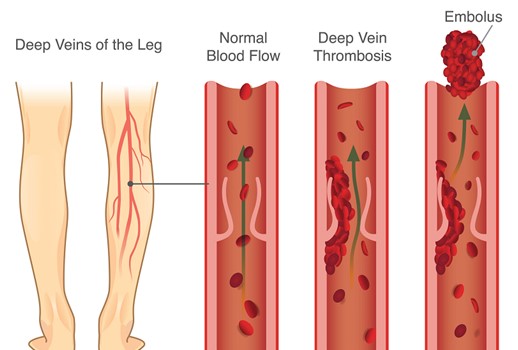A pulmonary embolism (aka PE) is when a clump of material, usually a blood clot, obstructs an artery in the lungs.
DVT & PE conditions are often underdiagnosed and serious, but preventable medical conditions.
It is important to know about DVT & PE because it can happen to anybody and can cause serious illness, disability, and in some cases, death. xiii
Deep Vein Thrombosis & Pulmonary Embolism Complications
The most serious complication of DVT happens when a part of the clot breaks off and travels through the bloodstream to the lungs, causing a blockage called pulmonary embolism (PE). If the clot is small, and with appropriate treatment, people can recover from PE. However, there could be some damage to the lungs. If the clot is large, it can stop blood from reaching the lungs - a fatal condition.
In addition, nearly one-third of people who have a DVT will have long-term complications caused by the damage the clot does to the valves in the vein called post-thrombotic syndrome (PTS). People with PTS have symptoms such as swelling, pain, discoloration, and in severe cases, scaling or ulcers in the affected part of the body. In some cases, the symptoms can be so severe that a person becomes disabled.
For some people, DVT and PE can become a chronic illness; about 30% of people who have had a DVT or PE are at risk for another episode.[i]
To learn more, please register for training at https://ceinstitute.com/
#massage #massagetherapy #massageprecautions #massagecontraindications
[i] Division of Blood Disorders National Center on Birth Defects and Developmental Disabilities. “Venous Thromboembolism (Blood Clots).” Centers for Disease Control and Prevention, 18 Apr. 2018, www.cdc.gov/ncbddd/dvt/facts.html.


Fatima Frisco - September 05, 2025
HIRE. THE HACK ANGELS // BEST BITCOIN // CRYPTO // ETH // USDT // WALLET RECOVERY EXPERT
If you are a victim of a crypto investment scam, send your crypto to the wrong address or someone hacked your wallet, THE HACK ANGELS can recover your funds!. After losing $855,60 to a scam, I spent three months searching for help. THE HACK ANGELS came through when no one else could. They recovered my funds and gave me hope again. I realized that even in the darkest moments, there’s always a way forward. Don’t give up if you’re facing a similar situation. Reach out to THE HACK ANGELS Expertise for guidance and support. Contact.
WhatsApp (+1(520)200-2320 ), or shoot them an email at (support@thehackangels.com) They also have a great website at (www.thehackangels.com)
I’m grateful for their help and highly recommend their services to anyone out there.
Rita Gliner - July 11, 2025
DO YOU REQUIRE TECHNICAL SKILLS TO SOLVE YOUR HACKING RELATED PROBLEMS?
●Hacking of all social media accounts
●Spying on cheating partner
●Retrieving of lost Cryptocurrency
●Data alteration
●Finding of lost phone
●Clearing/paying off of mortgage/loan
●Increasing of credit score
●Bitcoin mining
●Tracking of location
●Hacking of cell phone/other devices
●Block out or track down hackers
Secure yourself now!!!
Contact: cyberhelpdesk88@gmail.com
WhatsApp: +1 (209) 809-0176
Telegram: +1 (209) 809-0176
quatisha brown - April 07, 2025
I just want the whole world to know about this spell caster I met two weeks ago,I cannot say everything he has done for me and my family I was going through online when I meant this wonderful man’s testimony online how he won a lottery through the help of dr Ose I decided to just give it a try and my life is back to me now after i lost my job due to covid he gave me a winning numbers to play lottery and i won 5000usd for my first play since then i have been working with him and he has been giving me numbers to play my lottery i can not write everything he has done for me if you need a lottery spell today contact him on
Https://drosetemple.com oseremenspelltemple@gmail.com
quatisha brown - January 31, 2025
Https://drosetemple.com
oseremenspelltemple@gmail.com